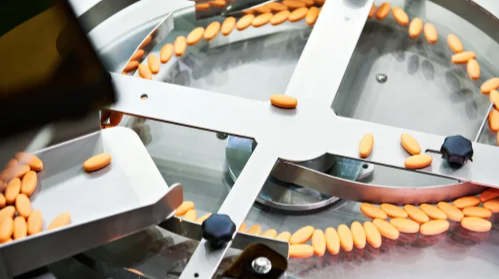Introduction
The healthcare industry is constantly evolving and improving thanks to new technologies, especially for pharmacies. Pharmacies require many different systems to stay precise, accurate, and timely so it is important to always stay up to date with the latest technology when it comes to this profession.
Pharmacy automation has been at the forefront of the technology transformation to benefit healthcare professionals and patients alike. The ability to automate everything from repetitive tasks to the seamless sharing of health records has improved the way pharmacists work effectively and manage patient prescriptions.
Let’s explore some of the current trends in pharmacy automation solutions and their impact on the industry.
Pharmacy Automation Explained
Pharmacy automation is the mechanically engineered process of handling and dispensing medications. There are many different types of automation machines that range from websites and programs to organize your pharmacy to dispensing robots that can count and dispense medications. Other examples of automation include patient medication record systems, digital displays, prescription recording applications, pharmacy management systems, prescription collection points, and so much more.1 The market for pharmacy automation is quickly expanding and becoming more common due to the large benefits of these machines and the limited amount of time at work pharmacies have.
Let’s dive deeper into the most common automation devices pharmacies use. Dispensing robots are used to count pills, put labels on prescription vials, store drugs and access patient information. Dispensing is a common cause of medication errors for pharmacies and also takes a lot of time away from other more important pharmacy duties. Automated dispensing machines allow pharmacists and pharmacy technicians to put more time into important valued tasks rather than counting prescriptions while decreasing room for error.2 The prescriptions are also at increased safety and confidentiality since they are stored in a secure and sterile environment. Automated dispensing cabinets are the most common form of dispensing robots and are seen mostly in inpatient pharmacy settings. Another increasingly popular electronic device used is pharmacy management systems (PMRs). This software is used to organize and store all of the business-related information in the pharmacy ranging from human resources information to training to stock levels and even patient data.1
All of these different electronic technologies aim to achieve the same goals – improving speed, security, and efficacy while reducing cost and error. This helps to manage workflow, control costs, and improve accuracy which overall helps the pharmacists with operational concerns. Recently, pharmacy automation needs have been at an all-time high due to the increased demand for pharmacy workers along with an increase in medication costs. Many employees have opted to work from home now due to the COVID-19 pandemic causing labor shortages but inversely an increase in medication numbers, costs, and drug shortages. This imbalance resulted in propelling pharmacy automation device demand of a 60% increase across the United States.3
Benefits of Pharmacy Automation
The recent rise in demand accompanied by a drop in supply has caused the pharmaceutical industry some trouble. Pharmacy automation has made this shift easier with its help in integration, efficiency, and productivity allowing pharmacists to spend more time with patient-centered problems. Using automation, time-consuming tasks can be delegated from pharmacists to engineered pharmaceutical machines to ease some of the pharmacy’s manual activities.
Pharmacy automation solutions aim for five main benefits – improved accuracy, better inventory, enhanced workflow, better patient experience, and reduced labor costs. Poor accuracy puts pharmacists and their patients at risk of receiving incorrect dosing or medications. Using pharmacy automation improves accuracy by removing the option of human error when verifying and dispensing medications. These engineered machines also keep real-time logs of what is going in and out of the device so inventory management is taken care of. Statistics are acquired to show the most used medications to keep in stock and which medications are bought and wasted. Paper filing is not needed since it is all stored electronically. Staff workflow will flourish regardless of the increase in demand. Employees can be more productive in more important areas of the pharmacy rather than the time-consuming easier tasks that may be taking up their whole day. One area of increased productivity is improving patient care with better assistance, recommendations, and insight for customers who need help with their medications. Automation removes the need to hire more staff regardless of the increase in prescriptions while also minimizing medication errors. This reduces costs in pharmacies immensely.4
With this being said, the overall goal of pharmacy automation is to make pharmacies safer and improve patient safety. Decreasing the workload on pharmacists so they are able to slow down and help patients, enhancing workflow, and improving the accuracy of work are ways that medication errors can be minimized and avoided. About 5% of patients hospitalized experience an adverse drug event from a medication error. Advancements in technology and pharmacy automation will help decrease the incidence of these errors and further improve patient outcomes and experiences.5
Current Trends in Pharmacy Automation Systems
The current most popular trends in the global pharmacy automation systems market include medication dispensing systems, robotics, artificial intelligence (AI), telepharmacies, and automated inventory management systems. Many of these devices have completely different goals and purposes but overall have the same aim – improving patient outcomes and accuracy while decreasing medication errors and costs.
As mentioned previously, medication dispensing systems are one of the most used pharmacy automation devices. These systems store, dispense, and track medication through inpatient hospital pharmacy settings, improving patient safety. This tracking ensures the patients receive the right drug and right dose, prevents drug diversion of controlled substances, monitors patient medication use, and so much more. These systems are automated locked medication storage units that only a few specific personnel have access to.6
Robotics and AI are now being used for pharmacy automation. Pharmacy robotics are mechanical devices that mimic human behavior once programmed, without continuous help from the operator. For example, many medication dispensing systems are considered robotic along with pharmacy barcoding and automated workflow systems.7 AI has been trending as a new up-and-coming area of technology in pharmacy to be used for things such as drug discovery, computer programs, dosage form designing, polypharmacology, and hospital pharmacy. AI is generally used to imitate the cognitive tasks of humans, which is why it may start playing a big role in the pharmaceutical industry. It can be applied to digital computers or computer-controlled robots (like automated dispensing cabinets) to execute human-like functions. Top pharmaceutical companies are starting to incorporate AI technology for research and development, drug discovery, healthcare system analysis, the accuracy of medicine, health support and medical assistance, assisting in repetitive tasks, treatment plan design, and maintaining health records. In the retail pharmacy setting, AI can be implemented via inventory management, telehealth partnerships, and using chatbots to mimic patient-pharmacist interactions. In the hospital pharmacy setting, AI can be implemented via automated dispensing and tracking, preparation of injectable medications, barcode scanning, and much more.8
Another trend that is becoming more popular in pharmacy automation is telepharmacy. Telepharmacy is the act of a pharmacist delivering care to patients through electronic telecommunication. Pharmacists can use telecommunication to oversee patient care through dispensing medications, reviewing patient drug use, monitoring patients, and more. This makes it much more convenient for patients to talk to pharmacists, especially if they cannot make it into a physical pharmacy. The key benefits of telepharmacy include convenient and safe treatment from professionals, improved health services in rural areas, extended pharmacy support, improved medication adherence, and enhanced operations for providers. Telepharmacies are a convenient way for patients to get accurate information from professionals and may soon be the way of the future.9
Automated inventory management systems help pharmacies keep track of their stock and inventory in real time with minimal human intervention. Tracking stock is a crucial part of one’s job at the pharmacy but is also time-consuming and tedious. Pharmacies may now use automated inventory management systems to delegate this task to robotic systems and focus more on patient care. These machines can also generate reports with the exact ins and outs of stock so pharmacies have full records of each medication without the extra steps of doing it manually.10
The Future of Pharmacy Automation
The driving factors of the pharmacy automation system market include the vast benefits it brings to pharmacies. Automation reduces costs and medication-related errors while improving accuracy, pharmacy workflow, and patient experience. The global automation market is expected to rise exponentially in the years to come mainly due to an increase in prescription demand, technical equipment, and expansive technological knowledge. Digital healthcare is continuously expanding and taking over the industry.
The demand for pharmaceutical drugs has increased with infection rates since the beginning of the pandemic which is what initially increased pharmacy automation equipment prevalence. With the number of prescriptions rising along with the number of older people, automation will continue to flourish in the profession of pharmacy with great impact. Currently, automation integrates automated dispensing, packaging, storing, labeling, etc to reduce dispensing errors and increase pharmacy leader’s productivity. From here, the business will just continue to expand with the help of electronics and technology.11
Conclusion
Pharmacy automation has evolved exponentially in recent years and is continuing to do so. Not only does it reduce costs and help with business workflow but it also improves patient outcomes by improving accuracy, reducing medication errors, and giving pharmacy personnel more time to tend to their patients. Whether it is a small technology advancement like a software download or a big addition of a robotic automated dispensing system to an inpatient hospital, technology has improved the way pharmacists work entirely.





